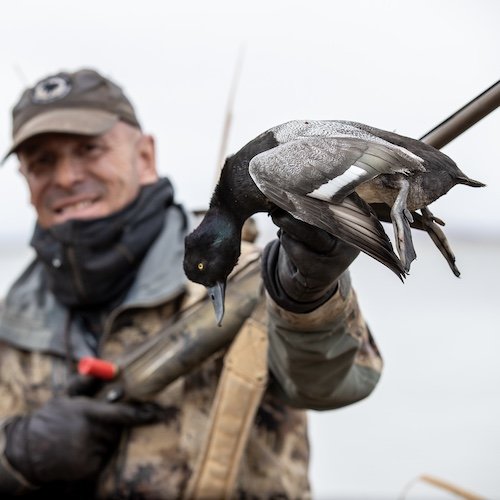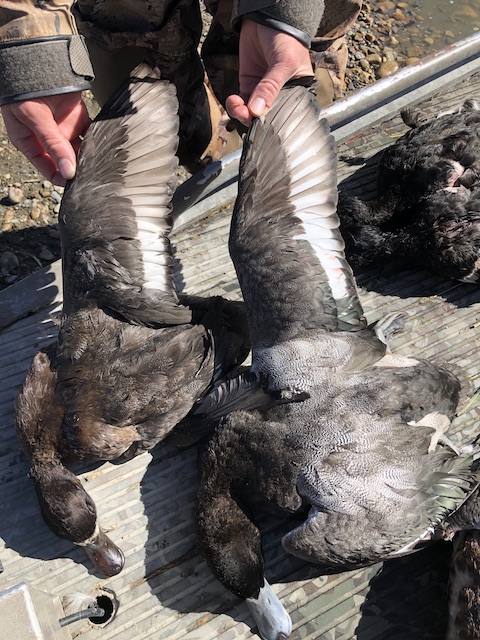Lesser Scaup
 The Lesser Scaup (Aythya affinis) is the most abundant diving duck in North America. Lesser scaup are the North American counterpart to the Old World tufted duck. Depending on where you’re hunting in the US, you’ll hear several nicknames to include blackheads, bluebills or dogris (pronounced doe-gree). Drake scaup display monochromatic color scheme, finely vermiculated plumage, bold yellow irises and the blue-bills from which they’ve derived their colloquial moniker. Upperwings are dark, very finely vermiculated; secondaries are white. Both sexes have blue gray bills tipped with black, however the hen has a much darker color. Both have short, gray legs and feet. Hen scaup have white plumage around their bill and a gray brown head. The drake has a black head that extends to the chest, a white underbelly, and white and gray vermiculated body plumage. The hen also shows this white underbelly however has chestnut plumage covering the rest.
The Lesser Scaup (Aythya affinis) is the most abundant diving duck in North America. Lesser scaup are the North American counterpart to the Old World tufted duck. Depending on where you’re hunting in the US, you’ll hear several nicknames to include blackheads, bluebills or dogris (pronounced doe-gree). Drake scaup display monochromatic color scheme, finely vermiculated plumage, bold yellow irises and the blue-bills from which they’ve derived their colloquial moniker. Upperwings are dark, very finely vermiculated; secondaries are white. Both sexes have blue gray bills tipped with black, however the hen has a much darker color. Both have short, gray legs and feet. Hen scaup have white plumage around their bill and a gray brown head. The drake has a black head that extends to the chest, a white underbelly, and white and gray vermiculated body plumage. The hen also shows this white underbelly however has chestnut plumage covering the rest.
While both are referred to as blue-bills, following are a few clues for differentiating between lesser scaup and relatively less abundant greater scaup. Both have white secondary bands, but the white is limited only to the secondaries in lesser scaup. In greater scaup, this white band extends into the primaries. In hand, the black head sheen is purplish on lesser scaup but a greenish on greater scaup. Greater scaup bills are slightly wider, giving rise to the colloquial nickname “broadbill.”
Available Hunts
-
Louisiana Duck Hunting – Coastal Marsh at Venice
Never more than 3 steps away from the duck blind - Inclusive package for individuals, families, and corporate groups that want to cast or blast (or cast and blast) while living it up like cajun kings.
...read more- Coastal Louisiana duck hunting, inshore or offshore fishing, perfect Cast & Blast
- Premium lodging and excellent chef-prepared meals featuring regional specialties
- Spacious lodge sleeps up to 18
- Accepts booking 1-18+ (no mixed groups)
- Excellent early blue-winged teal hunting (September), regular duck season November-January)
- Plus inshore and offshore fishing
Rate: $500/day -
Mexico Duck Hunting Mazatlan
Mexico duck hunting Mazatlan ("honeymoon duck hunt") is the South-of-the-border duck hunting experience that surpasses all others.
...read moreMexico Duck Hunting Mazatlan is the easiest duck hunt you’ll ever get your wife onboard with because she’ll have just as much fun. Win-win duck hunting vacation as ever existed.
- Honeymoon duck hunting, non-hunting spouses enjoy it as much as hunters!
- January through mid-March (Valentine’s Day always sells-out first!)
- Resort hotel lodging, guaranteed great views (choose your own reservations and amenity levels while booking directly)
- Over 15 trophy duck species including Cinnamon Teal
- Generous 25-duck daily bag limits
- Many fun non-hunting activities
Rate: from $3,850 -
Mexico Duck Hunting Nayarit
I invite you to experience authentic Mexico duck and dove hunting at its very best. INCLUSIVE Mexico Duck Hunting Nayarit Combo is genuine yesteryear Mexico duck hunting
...read moreAvailable only through GetDucks.com, the Nayarit Mexico duck hunt combo package represents superior bang-for-the-buck value and is truly inclusive, including everything but flying into to Mazatlan and the ammo you shoot.
- Includes everything but flying into Mazatlan and your ammo. That’s it!
- Morning ducks, afternoon doves, 6 hunts, generous limits
- Prized species include blue-winged teal, cinnamon teal, green-winged teal, northern shovelers, black-bellied whistlers, fulvous whistlers, more.
- Minimum 4 hunters, maximum 6, exclusive groups only.
- Best, most authentic meals in Mexico.
- Minimum 4 hunters
Rate: $4,240 INCLUSIVE -
Mexico Duck Hunting Obregon
Mexico duck hunt combo for real duck hunters. All-day hunts for broad variety of Central Flyway and Pacific Flyway duck species.
...read moreMexico duck hunting combo in Obregon is an action-packed “real duck hunters duck hunt” for ducks, doves, options for trophy bass fishing and quail.
- Trophy duck species for nearly all Central and Pacific flyway species to include cinnamon teal, Mexican mallard, more!
- Generous bag limits
- Elegant and Gambel’s quail, trophy largemouth bass fishing options
- Premium, 9-bedroom estancia and unequalled guest services
- Featured – Wildfowl, World of Beretta, MOJO TV, Outdoor Life, NRA Hunter, more
Rate: $4,880 (4-day hunt) -
New England Sea Duck Hunting
World renown for its eider hunting, New England waterfowling offers an incredible change of scenery and is an excellent place to check off lots of North America waterfowl species. Codfather Charters specializes in making your hunt priorities a reality.
...read more- Decade-plus experience for trophy eiders, other sea ducks, divers, dabblers, mergansers, geese
- Best place in US to harvest prime American black ducks
- Customized hunt plans reflect hunter priorities, not a “one size fits all” type 1/2-day hunt
- Includes hotel accommodations, full-day hunting, continental breakfasts, made-to-order lunches
- Recognized as foremost among US waterfowl collectors and taxidermists
- Nearby non-hunting spouse activities abound
Rate: $2,500 for 3-day inclusive package -
Oklahoma Duck Hunt
Oklahoma duck hunting a little over an hour drive from Dallas - as good as it gets. We've promoted this hunt for a very long time, always happy client feedback.
...read moreExcellently guided Oklahoma duck hunts are located a little over an hour north from Dallas. Perfect opportunity for a morning hunt before work or an easy weekend hunt with friends, family or business associates.
- Located 1 to 1.5 hours from downtown Dallas
- Expertly-guided Oklahoma duck hunts, afternoon hog hunting available
- Oklahoma and Texas depending on bird activity
- Mostly dry blinds, waders not always needed
- Cabin accommodations for up to 8 can be provided
- Meals not included
Rate: $400 per morning -
Texas Waterfowl Hunt – Desert Paradise
Texas waterfowl hunt packages features relatively unpressured ducks, geese and sandhill cranes in an area so large it takes 3 lodges to cover and so ecologically diverse that most Central Flyway waterfowl species can be hunted!
...read more- Inclusive Texas waterfowl hunting packages for ducks, geese, sandhill cranes, doves, early blue-winged teal, spring turkeys, more.
- 3 lodges to cover vast, relatively undisturbed waterfowl hunting area and to offer flexibility for desired bucket-list species, amenity-level needs, or personal budget
- Central flyway puddle ducks to include prized mottled duck, Mexican duck, cinnamon teal, fulvous whistling duck, black-bellied whistling duck opportunities all right here in USA
- Sandhill crane hunting and white-fronted goose hunting are the Speck Ops Waterfowl house specialties
- Luxurious lodging with over-the-top and fun activities provide fun for bachelor or business hunting groups, entire families and non-hunters,
Rate: $2,000 to $2,900

Lesser scaup can be found breeding in the prairie pothole region in the Northern United States and Canada, taking advantage of fresh and brackish waters. The most concentrated areas of use are central Canada. Hens choose to nest either on the ground in tall prairie grasses or build platforms above the water. When ducklings down dries, they immediately leave the nest to join the adults in the water. During the other times of year, lesser scaup use any kind of water for foraging. The lesser scaup’s diet is primarily made up of aquatic invertebrates, such as insects and mollusks that are found in soft mud. They also readily consume stems and seeds of emergent aquatic plants.
Lesser scaup may tend to range further south than greater scaup. The wintering region includes the west and east coast of the United States, the southernmost states, well into Mexico. Many reside in Florida, California, Oregon, Washington, and the Gulf of Mexico. During the non-breeding season, it is common to see the Lesser Scaup socializing or flying with other ducks such as greater scaups, canvasbacks, and redheads.
Scaup are an important species to the US hunting tradition, especially in the northern half of the US. Interestingly, despite a continental population greatly exceeding redhead and canvasback, scaup limits were only one daily throughout much of the continental US in 2020. Blue-bills are a bread-and-butter duck for many die-hard diver duck hunters. For more information, listen to the Duck Season Somewhere podcast episode But What About Bluebills?







